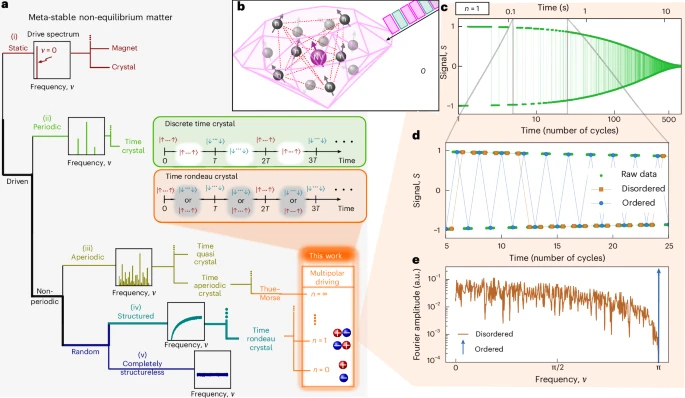Rewriting the Rules of Time: Experimental Observation of a "Time Rondeau Crystal"

A team of researchers from institutions including UC Berkeley, the Max Planck Institute for the Physics of Complex Systems, and Peking University has experimentally demonstrated a novel state of quantum matter: the time rondeau crystal. Reported in Nature Physics (doi:10.1038/s41567-025-03028-y), this breakthrough extends the landscape of temporal order in driven many-body systems well beyond conventional time crystals. Using hyperpolarized 13C nuclear spins in diamond and structured random drives, the researchers have observed a new hybrid temporal structure characterized by coexisting long-range temporal order and short-time temporal disorder.
From Symmetry Breaking to Time Crystals
In condensed matter physics, different phases of matter can often be understood through the lens of symmetry breaking. For instance, ice breaks the continuous translational symmetry of space by forming a regular crystalline lattice. In 2012, Frank Wilczek proposed the concept of a “quantum time crystal,” a phase of matter that breaks time-translation symmetry spontaneously. Although equilibrium systems cannot host such phases, non-equilibrium periodically driven (Floquet) systems can. Over the last decade, discrete time crystals (DTCs) have been observed in various platforms ranging from trapped ions to solid-state spin ensembles.
Time crystals exhibit periodic responses at multiples of the driving period, showing long-range temporal order analogous to spatial crystals. However, their dynamics are usually rigid and deterministic. The new “time rondeau crystal” concept disrupts this paradigm by introducing structured randomness in time, creating a unique coexistence of predictable long-time behavior with disordered short-time fluctuations.
What Is a Time Rondeau Crystal?
The researchers classify temporal order by examining the Fourier spectrum of the driving fields. On one end, periodic drives produce discrete Fourier spectra leading to standard DTCs. On the other, fully random drives yield temporal disorder. Between these extremes lie structured random drives, such as random multipolar drives (RMDs), which combine deterministic stroboscopic order with tunable randomness on shorter timescales.
This alternating structure is reminiscent of the rondeau form in classical music, where a recurring theme alternates with contrasting episodes—famously exemplified by Mozart’s Rondo alla Turca. Similarly, the time rondeau crystal shows stable period-doubling oscillations at stroboscopic times, while the intra-period dynamics are intentionally randomized. This state was created and observed in a macroscopic quantum system of 13C nuclear spins in diamond at room temperature.
The Experiment: Diamond Spins and Structured Randomness
Using a custom high-memory arbitrary waveform generator, the team applied carefully engineered pulse sequences to a diamond crystal with natural 13C abundance. They combined fast spin-locking sequences to protect transverse polarization with slower, structured random drives to induce temporal order. By adjusting the multipole order of the drive, they controlled the degree of temporal disorder while maintaining stable long-range temporal oscillations over lifetimes exceeding 4 seconds—corresponding to hundreds of drive cycles.
The distinctive signature of the time rondeau crystal emerges in the Fourier spectrum: while stroboscopic measurements show a sharp peak at half the drive frequency, indicative of period-doubling, the micromotion spectrum is smooth and broad, reflecting temporal disorder. This contrast serves as a clear “smoking gun” for rondeau order, distinct from both Floquet time crystals and quasicrystals.
Potential Applications and Future Directions
Beyond its conceptual novelty, the ability to engineer arbitrary micromotion dynamics without sacrificing temporal order opens exciting possibilities. For example, the team demonstrated encoding binary information directly into the micromotion signal of the time rondeau crystal—effectively using the temporal disorder as an information carrier. This capability could be leveraged for quantum sensing, frequency-selective detectors, or robust time-based information storage.
The work also highlights the robustness of rondeau order to perturbations and its independence from fine details of the drive, pointing toward broader applicability in other quantum platforms. Potential extensions include systems based on photoexcited triplet electrons, where even longer rondeau lifetimes are anticipated, and applications in quantum metrology, cat-state preparation, or topological transport phenomena.
Original article: “Experimental observation of a time rondeau crystal”, Nature Physics (2025).
📝 This article was prepared with the help of AI technologies.
Sponsored by PWmat (Lonxun Quantum) – a leading developer of GPU-accelerated materials simulation software for cutting-edge quantum, energy, and semiconductor research. Learn more at https://www.pwmat.com/en.
📘 Download the latest brochure: PWmat PDF Brochure
🎁 Try PWmat for free: Request a Free Trial
📞 +86 400-618-6006
📧 support@pwmat.com
© Quantum Server Networks — All rights reserved.
#TimeCrystals #QuantumPhysics #RondeauOrder #NonEquilibriumMatter #NaturePhysics #DiamondSpins #QuantumMaterials #CondensedMatter #PhysicsResearch #PWmat #QuantumServerNetworks

Comments
Post a Comment